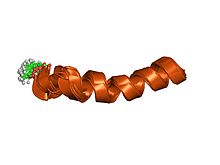| VPR | |||||||||
|---|---|---|---|---|---|---|---|---|---|
 solution structure of hiv-1 vpr (13-33) peptide in micells | |||||||||
| Identifiers | |||||||||
| Symbol | VPR | ||||||||
| Pfam | PF00522 | ||||||||
| InterPro | IPR000012 | ||||||||
| SCOP2 | 1dsk / SCOPe / SUPFAM | ||||||||
| TCDB | 1.A.42 | ||||||||
| |||||||||
Vpr is a Human immunodeficiency virus gene and protein product.[1][2] Vpr stands for "Viral Protein R". Vpr, a 96 amino acid 14-kDa protein, plays an important role in regulating nuclear import of the HIV-1 pre-integration complex, and is required for virus replication and enhanced gene expression from provirus in dividing or non-dividing cells such as T cells or macrophages.[3] Vpr also induces G2 cell cycle arrest and apoptosis in proliferating cells, which can result in immune dysfunction.[4][5]
Vpr is also immunosuppressive due to its ability to sequester a proinflammatory transcriptional activator in the cytoplasm. HIV-2 contains both a Vpr protein and a related (by sequence homology) Vpx protein (Viral Protein X). Two functions of Vpr in HIV-1 are split between Vpr and Vpx in HIV-2, with the HIV-2 Vpr protein inducing cell cycle arrest and the Vpx protein required for nuclear import.
- ^ Vpr+Gene+Products,+Human+Immunodeficiency+Virus at the U.S. National Library of Medicine Medical Subject Headings (MeSH)
- ^ Genes,+Vpr at the U.S. National Library of Medicine Medical Subject Headings (MeSH)
- ^ Bhardwaj V, Singh A, Choudhary A, Dalavi R, Ralte L, Chawngthu RL, et al. (September 2023). "HIV-1 Vpr induces ciTRAN to prevent transcriptional repression of the provirus". Science Advances. 9 (36): eadh9170. doi:10.1126/sciadv.adh9170. PMC 10482341. PMID 37672576.
- ^ Bukrinsky M, Adzhubei A (1999). "Viral protein R of HIV-1". Reviews in Medical Virology. 9 (1): 39–49. doi:10.1002/(SICI)1099-1654(199901/03)9:1<39::AID-RMV235>3.0.CO;2-3. PMID 10371671.
- ^ Muthumani K, Choo AY, Zong WX, Madesh M, Hwang DS, Premkumar A, et al. (February 2006). "The HIV-1 Vpr and glucocorticoid receptor complex is a gain-of-function interaction that prevents the nuclear localization of PARP-1". Nature Cell Biology. 8 (2): 170–179. doi:10.1038/ncb1352. PMC 3142937. PMID 16429131.
